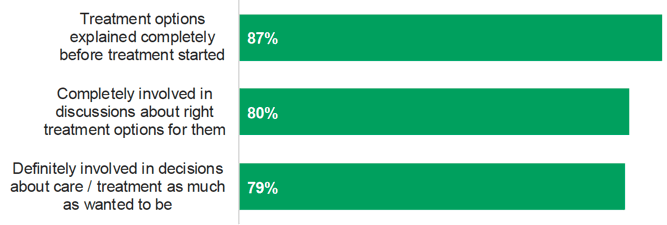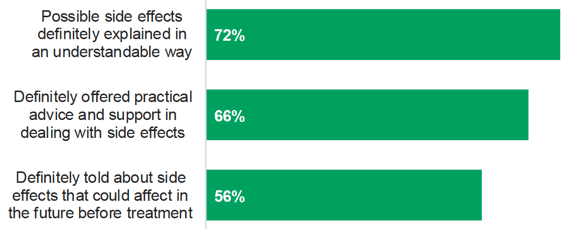Scottish Cancer Patient Experience Survey 2018: national report
National results from the 2018 Scottish Cancer Patient Experience Survey.
This document is part of a collection
6. Deciding on the Best Treatment
Summary
- Most people (87 per cent) felt their treatment options were completely explained before their treatment started.
- Around four in five people were positive about being involved in discussions about the right treatment options and in decisions about their care (80 and 79 per cent respectively).
- People were broadly positive about advice on possible immediate side effects, with 72 per cent reporting they were explained in a way they could understand and 66 per cent being offered practical advice and support.
- Respondents were less positive about potential future side effects, with 56 per cent reporting they were definitely told about these.
Treatment Options
It is important that individuals feel fully informed to be able to make the decisions about which treatment, if any, they want to undergo. Most people (87 per cent) reported that their treatment options were ‘completely’ explained before their treatment started. This is consistent with results from 2015. Eleven per cent of people felt that their treatment options were explained ‘to some extent’ and three per cent reported they were not explained.
The survey also asked respondents whether they were involved in discussions with healthcare professionals about the right treatment options for them, which may have included the option of not treating their cancer. Four in five people (80 per cent) reported that they were ‘completely’ involved in these discussions. Sixteen per cent felt that they were involved to some extent and four per cent reported that they were not involved but would have liked to discuss this.
Almost four-fifths of people (79 per cent) felt that they were ‘definitely’ involved in decisions about their care and treatment as much as they wanted to be which is consistent with 2015 figures. Seventeen per cent were involved to some extent and four per cent reported that they were not but would have like to be more involved.
Figure 6.1: Proportion of positive responses to questions on treatment options

Side Effects
Just over seven in ten people (72 per cent) felt that the possible side effects of their treatment(s) were definitely explained in a way they could understand. This is in line with results from 2015. Almost one in four people (23 per cent) reported that they were explained in an understandable way to some extent. Four per cent of people did not receive an explanation but would have liked one.
Two thirds of people (66 per cent) were offered practical advice and support in dealing with the side effects of their treatment(s) which is consistent with results from 2015. Around a quarter (26 per cent) were offered advice to some extent and eight per cent of people were not offered any practical advice or support.
As more people continue to live with cancer, understanding side effects of treatment which may affect them in the future, as well as immediately, becomes increasingly important. Slightly more than half of respondents (56 per cent) were told about any side effects of the treatment that could affect them in the future, rather than straight away, before they started their treatment. This was an increase from 54 per cent in 2015. Almost one third of people (31 per cent) reported that they were told to some extent and 13 per cent were not told but would have liked an explanation.
Figure 6.2: Proportion of positive responses to questions on side effects

Contact
Email: euan.smith@gov.scot
There is a problem
Thanks for your feedback